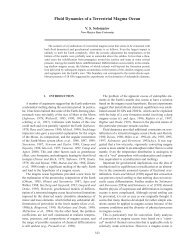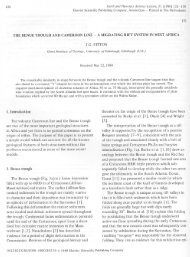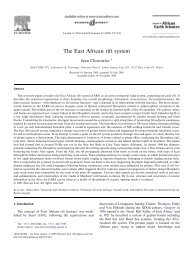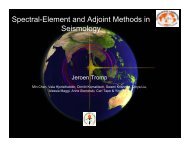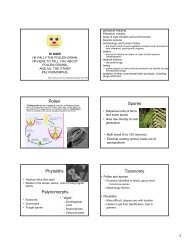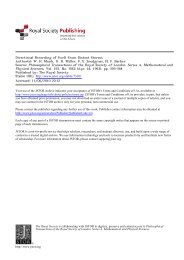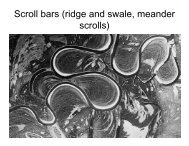High-Resolution Frequency-Wavenumber Spectrum Analysis
High-Resolution Frequency-Wavenumber Spectrum Analysis
High-Resolution Frequency-Wavenumber Spectrum Analysis
- No tags were found...
You also want an ePaper? Increase the reach of your titles
YUMPU automatically turns print PDFs into web optimized ePapers that Google loves.
1416PROCEEDINGS OF THE IEEE, AUGUST 1969TABLE I1PAR.4hIETER.S FOR 21 NOVEMBER 1966 KURILE ISLANDS EVENTCONVENTlONAtNHIGH RESOLUTIONNDate : 21 November 1966Region :Kurile IslandsOrigin time: 12:19:27Latitude:46.7 NLongtude:152.5 EDistance:64.3'Azimuth: 312'Depth:40 kmBody-Wave Magpitude: 6.05WAVENUMBER (cyclerlhmlE W EFREQUENCY = 0.03 Hz(PI21 NOV 66KURILE ISLANDS EVENT12:40:00 T0..13:40:000SWAVENUMBER Icyckrlkm)CONVENTIONALNHIGH RESOLUTIONEW--21 NOV 66KURILE ISLANDS EVENTFig. 6. The long-period waveforms for 21 November 1966Kurile Islands event.eters are given in Table 11. TIE LPZ Rayleigh surface wavesof this event are shown in Fig. 6. The results obtained bymeasuring the frequency-wavenumber spectrum over theentire LPZ Rayleigh surface-wave train, as indicated inTable I, are given in Fig. 7 for frequencies of 0.03, 0.04,0.05 Hz. It is known that the beating, or modulation, of theenvelope of these surface waves, as shown in Fig. 6, is causedby multiple path propagation, especially at shorter periods,cf. [6]-[8]. This multipath propagation effect is shownquite clearly at 0.04 Hz where two peaks are resolvable. Onepeak is at an azimuth corresponding to the initial wavearriving along the great circle path between LASA and theKurile Islands, while the other peak shows the later multipatharrival propagating from the northwest.In order to determine the time-delay between the multipatharrivals at LASA, for the 25-second period group, thefrequency-wavenumber spectrum was measured over successive200-second-long blocks of time, as indicated inTable I. The results are given in Fig. 8, which, for simplicity,shows only the high-resolution results. Fig. 8(a) shows thatthe initial 25-second period group arrives from approximatelythe azimuth of the event, while Figs. 8(bHd) showthe later arrivals coming from a more northerly direction.The time delay between the multipath arrivals appears tobe about 200 seconds, since the emergence of a secondarypeak to the north is visible in Fig. 8(b). The group velocityfor these waves at the 25-second period is about 3.3 km/s sothat a path length difference of about 660 km or 6 degrees0 0.041 -OW5 0SSWAVENUMBER IcyckrltrnlWAVENUMBER (cyskrltmlFREOUENCY 0.04 Hz( b)21 NOV 66KURILE ISLANDS EVENT12:40:00 TO 13:40'00CONVENTIONALNIHIGH RESOLUTIONN0 W5E W E0 0 045SSWAVEWBER Icpkslkm)WAVENUMBER ~~hrltrnlFREPUENCY = 0.05 Hz(C)21 NOV 66KURILE ISLANDS EVENT12:40:00 TO 13:40:00Fig. 7. Conventional and high-resolution frequency-wavenumber spectrafor 21 November 1966 Kurile Islands event: 12:40:00 to 13:40:00.(a) <strong>Frequency</strong>=0.03 Hz.=0.05 Hz.(b) <strong>Frequency</strong>=0.04 Hz. (c) <strong>Frequency</strong>exists between the two multipath arrivals. Similar resultshave been obtained by Evernden by measuring phase velocitieswith a tripartite array [7], [8]. In addition, Everndengives a theory to explain the causes of the multipath propagationof Rayleigh surface waves.We now discuss the application of our results to SP noise.The transfer function of the SP system is shown in Fig. 9.Authorized licensed use limited to: WASHINGTON UNIVERSITY LIBRARIES. Downloaded on June 22,2010 at 13:34:08 UTC from IEEE Xplore. Restrictions apply.




